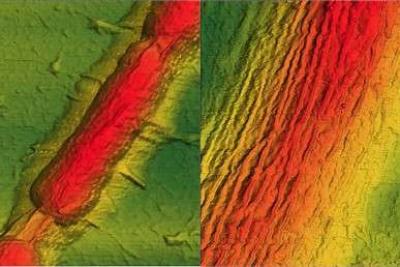Researchers from the University of Illinois at Chicago have used rod-shaped bacteria - precisely aligned in an electric field, then vacuum-shrunk under a graphene sheet - to cause nanoscale ripples in the material, causing it to conduct electrons differently in perpendicular directions. The resulting material can be applied to a silicon chip and may led to various applications in electronics and nanotechnology.

The team explains that the current across the graphene wrinkles is less than the current along them; The key to formation of these wrinkles is graphene's extreme flexibility at the nanometer scale, which allows formation of carbon nanotubes. The wrinkle opens a 'V' in the electron cloud around each carbon atom, creating a dipole moment, which can open an electronic band gap that flat graphene does not have.
Other researchers have created wrinkles in graphene, but these were not confined in microscale and cannot be directed towards a location on a micro-device. So the team came up with a unique way to introduce circumscribed, guided, and regular graphene ripples using bacillus bacteria, by using the graphene itself as a check-valve to alter the volume of the cells.
The researchers placed the bacteria in an electric field, causing them to line up in repeating rows. Then they applied a sheet of graphene over the top. "Under vacuum, the graphene lifts, and lets water out," they said. But under pressure, graphene sits back down on the substrate and prevents water from re-entering the bacteria.
The result is a nanoscopic valve that actuates unidirectional fluid flow in a microorganism. The researchers hope that in the future, this valve operation could be applied to microfluidic devices where flow is wanted in one direction but not the other.
After the bacteria have been vacuum-shrunk, the graphene reconforms, but with wrinkles. After heat treatment, the resulting permanent ripples on the bacteria are all aligned longitudinally, with a height of 7 to 10 nanometers, and a wavelength of about 32 nm. The wrinkles were observed by field emission scanning electron microscopy, which must be done under high vacuum, and by atomic force microscopy at atmospheric pressure.
According to the scientists, the ripple's wavelength is proportional to the thickness of the material, and graphene is the thinnest material in the world. Graphene could potentially enable the smallest wavelength wrinkles in the world - about 2 nanometers.
The next goal will be to create processes to further refine the ripples and vary their amplitude, wavelength and longitudinal length. The researchers stated that "Along with carbon nanotubes, graphene and fullerene, this is a new carbon allotrope - a half carbon nanotube linked to graphene". "The structure is different, and the fundamental electronic properties are new."